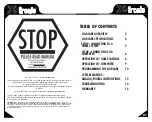
To chamber
& vacuum
trap (8)
(2)
(3 & 4)
(6)
(5)
1) Assemble ringstand rod and base.
2) Attach valve unit.
3) Attach reservoir bracket(s).
4) Insert syringes with stopcocks.
5) Insert short pieces of
3
/
16
" i.d. tubing
over tops of drippers, then insert
over syringe fittings.
6) Attach dripper tubing to upper valve
barb. Cut as desired, but leave
long enough to move reservoirs.
7) Insert green clamps on pieces of
1
/
16
" tubing between bottom valve
barbs and manifold.
8) Connect manifold outflow into
your perfusion chamber.
9) Plug numbered valve cables into
ValveLink8.2 ports.
(7) Green clamps
close to manifold
System Set-up Diagrams
Instructions on this page are for Economy perfusion systems, PTFE luer
lock valves, pressurized systems or pinch valve systems. Regular hose
barb PTFE perfusion systems please see the previous page. Luer lock
systems should also see the photo on page 5. Find additional photos and
diagrams of the pressure system on page 15.
(2)
(3)
(4)
1) Assemble ringstand base and rod.
2) Attach valve unit.
3) Insert syringes with stopcocks.
Pinch valves have no fittings.
Simply slide larger tubing over
small pinch valve tube above and
below the valves.
4) Connect tubing between bottom
valve tube and manifold.
5) Connect manifold outflow into
your perfusion chamber.
6) Plug numbered valve cables into
ValveLink8.2 ports.
Pinch Valve, Pressurized and Luer-Lock Perfusion Systems
Standard PTFE
Perfusion System
(without pressure)
Also see the "Installation Tips"
section on the next page.
Drippers are NOT included
with these systems because the
syringes are inserted directly into
valves.
Pressurized systems - no room for
drippers and may interfere with
pressure in tubes. Use provided
male luer locks to connect tubing
above each valve.
Roller "thumb" clamps
can be used here
(1)
(1)
AutoMate Scientific
®
R E A D Y F O R R E S E A R C H.
TM
(5) To perfusion chamber
and vacuum trap
9
8







































